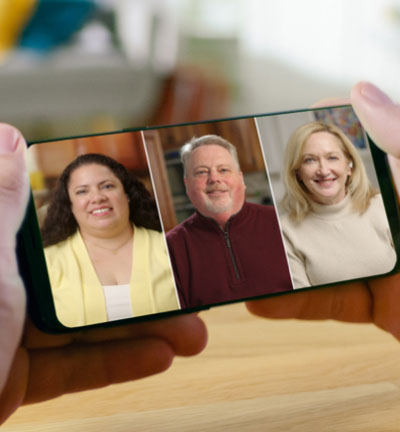Several modifications may be available to help make travel, work, housing and other experiences more accessible.
This article features personal stories from people living with MG who found ways to overcome challenging situations in their daily lives. Remember that every person’s experience is unique, and you should use your own judgment as it relates to your personal situation.
Basic parts of daily life that can appear easy for some might not be so simple for others. If you live with myasthenia gravis (MG), you may be familiar with this feeling. Living with a chronic illness and/or disability can sometimes make everyday tasks more challenging, which is why it’s important to understand what rights and accommodations you may be entitled to at public places, in a school setting, while traveling or in other situations.
Since there are several different types of MG symptoms that may affect each person differently, people living with MG may face a variety of everyday obstacles for which modifications could be helpful. Maybe ocular issues limit your ability to stare at a screen for your job, or perhaps fatigue makes it difficult to stand in line as you wait to board an airplane. In addition to identifying what modifications you may require, feeling empowered to ask for them may be just as crucial.
While you should always refer to federal and state laws such as The Americans with Disabilities Act (ADA) for up-to-date information on disability rights and laws, below are a few areas to consider as you think about challenges you may face with MG and where you may want to seek help.
Traveling and Public Transit
When traveling with MG, knowing what accommodations are available at the airport may be helpful. After feeling embarrassed to ask for a wheelchair and nearly missing flights, Zach,* a former UX designer who lives with MG, realized he needed to make a change. In addition to requesting a wheelchair, he also began asking to board the plane early.
The extra time allows people who use wheelchairs to get situated without feeling rushed and, when deplaning, they are usually the last to leave, giving them ample time to gather any belongings and exit comfortably.
If you’re taking public transit, such as a train or bus, certain accommodations can be made for you as well, such as lifts and ramps, adequate time to board, priority seating and slip-resistant surfaces.1 When Stephanie,* who also lives with MG, was turned away by a bus driver who refused to bring her aboard in her wheelchair, she knew she was entitled to a better outcome.
Don’t be afraid to demand the things you need.
Fortunately, another bus driver saw what happened, picked Stephanie up and took her where she needed to go. Additionally, that driver helped her gather the necessary information to file a complaint with the Department of Transportation. Having gone through this, Stephanie says self-advocacy matters when trying to access accommodations that aren’t being offered.
“Don’t be afraid to demand things that you need,” she expressed. “Just because you are disabled doesn’t mean that you are a bother.”
Work and School
If managing MG is interfering with your ability to focus on your job or schoolwork, it may be time to look for support. In Zach’s experience, the first step to consider is telling somebody at your workplace or school about your condition. Zach thinks it’s important to be transparent about this.
He shares what worked for him, “Bring it up sooner rather than later,” he said. “The last thing you want is to be perceived as performing poorly because you’ve got something else going on.” But, for others, it might make more sense to wait. It all depends on you and your comfort level.
While working as a UX designer, Zach started feeling symptoms that affected his ability to work. He ultimately told his manager about the illness, who helped ensure he received proper accommodations, like an adjusted schedule and equipment that was easier for him to use. However, Zach admits he was unsure how to approach the conversation at first—and whether he needed to do so with human resources (HR) as well.
Sheena, a Global Director of Diversity & Inclusion, suggests discussing your situation with your direct manager first, and then possibly bringing it to HR if you think your needs aren’t being addressed.
“Explain how you may benefit from some adjustments or a change in work environment to make it possible to perform your responsibilities,” she said.
Stephanie, who was both working full-time and pursuing her master’s degree at the time of her MG diagnosis, recalls how her symptoms impacted her day-to-day. As an insurance agent, Stephanie needed to interact with clients frequently and would often get fatigued, so she shared her situation with her manager and was ultimately given some accommodations, like using a voice recorder for her documentation duties.
Some common accommodations you could ask for, according to Sheena, are adjusted training materials (e.g., in larger print or read aloud), modified work schedules and devices with larger screens or assistive technology. She also notes that the U.S. Equal Employment Opportunity Commission (EEOC) has disability-related resources that could help you learn more about your options.
When it comes to schooling, accommodations may differ based on the level of education you’re pursuing or the school itself, and you can reference the U.S. Department of Education website for the latest details on what’s covered. Stephanie remembers that her graduate school program offered certain accommodations for students with disabilities, like note-taking assistance, but only during certain hours. Unfortunately, this didn’t work for Stephanie, as her classes were outside those hours.
Realizing those accommodations were intended for people like her, Stephanie gained the confidence to advocate for what she needed out of them. She ended up escalating the issue to the dean of students and was eventually given what she needed, when she needed it. Check with your school’s departments for clarity on what is offered and consider advocating for yourself if your needs aren’t being addressed.
Housing
Especially if you have difficulties with mobility, making modifications to your home may be helpful for you to save energy. It might feel overwhelming figuring out where to start, so working with a designer who is ADA-compliant could be a logical first step. Zach didn’t even know this option existed but was able to find out with a quick online search. By working with an ADA-compliant designer, Zach was able to make his house wheelchair accessible. Among the many changes he made were adding a stair lift, installing grab bars in the shower, and remodeling the kitchen to have lower countertops.
If you’re living in a rental, the Fair Housing Act entitles you to some options for making reasonable modifications, like a permitted transfer to a ground unit or a closer parking space.2 Reach out to your landlord to learn what else they may offer their tenants with disabilities, like potential changes directly to the living space for better accessibility.
In Stephanie’s case, she learned she could end her lease early since her safety was being compromised, living in a two-story rental while battling muscle weakness with MG. “I really liked the house, but physically couldn’t live there. I had fallen down the stairs and gotten a concussion, so it was dangerous for me with MG,” she explained.
Further Resources Available to Help
As you navigate your options for MG accommodations, remember to ask your healthcare team for help compiling any documentation to prove you qualify, if required. Zach worked with his doctors on this when he applied for a handicap parking permit, for example. Your doctors may also be able to suggest other accommodation ideas, like getting a service animal—something Stephanie ended up doing. She noted this was more than an emotional support animal; rather, it was a pet that could actively help her with physical tasks. If you’re comfortable having a pet, consider looking into the options for service animals where you live.
Support groups and advocacy organizations could also be great avenues to learn about possible accommodations you may not have thought of—not just for workplace and living conditions, but for accessing and experiencing public places as well. After becoming part of a support group himself, Zach took initiative to share his findings with others.
“Now I try to help other people in the group use resources, and I tell them to ask for accommodations,” he said. “If you can’t say what you need, no one is going to know. Self-advocacy is knowing how to be honest with yourself.”













